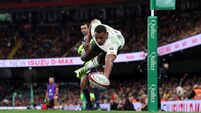Quality over quantity is desirable — and Dublin have both
"I read somebody in a newspaper giving out about the size of the pick of footballers in their county,” says the former Monaghan and Louth manager.
“So I wanted to find out if he was right. Total county populations aren’t accurate enough. You need to go a bit further than that.”
McEneaney had been scrutinising the 2011 Census for work he was doing as principal of Scoil Mhuire na mBuachaillí in Castleblayney.
But his research developed into something more as he realised a direct correlation between the figures he extrapolated and the game’s most successful counties.
“Of the All-Ireland winning counties in the last 25 to 30 years, all of them bar Armagh have come from the top 15 in that bracket of population.”
Armagh, McEnaney says, are over-achievers with just 4,500 men in the county between the ages of 20 and 30 in 2011, putting them 25th in his table. In his native Monaghan, that figure was just 3,500.
Leitrim ranked the lowest of the 32 counties with a paltry 1,706 while last year’s All-Ireland winners Donegal were 10th with 12,500.
Cork’s tally totalled 35,500, a distant second to Dublin with a whopping 107,000 20-something males in the county in their All-Ireland winning year.
To put that into context, Dublin’s gross pick is 1,244% greater than Kerry, their opponents tomorrow who are 13th with 8,600.
McEneaney acknowledges a tradition of football and religion as well as other variables play a determining factor in a county’s actual harvest but the capital’s web is enormous — and growing.
Dublin as a county has always been about size but now, so too is its football. As its population has grown, both the GAA and the board has reflected it by pumping large funds into coaching and development in the county.
The fruits are already being reaped at under-age inter-county level where U21 and minor All-Ireland success was achieved last year.
The portents for the senior side are positively dazzling. At the start of December, 53 players were brought into Jim Gavin’s training panel. So far, 38 have tasted either O’Byrne Cup or league action.
Including Kieran Donaghy, Kerry’s Eamonn Fitzmaurice has so far used 33 players, although that figure takes in five Dr Crokes players and Kenmare’s Paul O’Connor, whereas Gavin hasn’t gone near any of his Ballymun Kickhams players or Ciarán Kilkenny with Castleknock.
After the recent O’Byrne Cup semi-final win over Louth, Gavin suggested his players currently unavailable to him because of college and club commitments were at a disadvantage.
“The downside for them (in college) is that they’re not with me day-in, day-out and the same for the Ballymun Kickham guys.
“It’s great to see them in a semi-final coming up very shortly but the downside for them is that they’re not with us in the camp.”
Gavin can afford to issue such a quasi-warning. Fitzmaurice can’t. For him, it’s likely to be a case of getting his club-tied and injured players back into camp as soon as possible.
The Dublin players now coming through, having being produced and nurtured by Gavin and Dessie Farrell, are a different breed. By the time they’re making their senior debuts, they are already conditioned for the rigours of top level football.
But their football is not to be sniffed at either. As Paul Flynn said a couple of months ago, “The talent in Dublin football is frightening.”
Kilkenny is an obvious example but there’s Emmet Ó Conghaile, Kevin O’Brien and the electric Jack McCaffrey too. At the Australian Rules trials 12 months ago, Tadhg Kennelly reported the Clontarf teenager’s 20-metre sprint would have placed him at the top of the Australian draft in 2011.
But it’s his reading of the game that is so precocious for a 19-year-old. His interceptions of a number of Cork attacks in Croke Park last Saturday were exceptionally well-timed.
What Dublin boast in mass of development and catchment, they can equally brag in the volume of the team’s entourage. Ray Boyne’s appointment as the team’s head of performance analysis on Thursday made him the 19th man to join Gavin’s backroom team.
Boyne, who himself has a team of two working with him, was part of Paul Caffrey’s management group, which extended to as many as 15.
Its size was questioned and ridiculed when Dublin were obliterated by Tyrone in 2008 All-Ireland final, a defeat which convinced Caffrey to step down with immediate effect.
The same remarks about too many cooks spoiling the broth could be levelled at Gavin if results begin to slip but he comes with a winning pedigree and backed by potentially the most glittering generation of footballers in the county. When people harp about splitting Dublin, the county can’t point to one senior All-Ireland title in 18 years.
Expect the mouth of that yawning record to be snapped shut in the next few years. Dublin are filling their boots.











